Can a postman complete his mail route while only traveling down each street in his route exactly once? If so, he is going down down Eulerian walks. This project focuses on the development of a computer algorithm that can find Eulerian walks in graphs and being able to apply the concept in real life settings.
Mentor: Dr. Daniel Baczkowski
The two main problems from Good Will Hunting are the focus of this presentation. Learn about the solutions and ideas behind the problems as well as a brief history on the movie.
Student: Destiny DeWar
Mentor: Dr. Daniel Baczkowski
The Traveling Salesman Problem
The traveling salesman research project provides a background of the problem and a real-life model created to better understand the concept of the problem. The objective is to provide the audience with a greater understanding of the traveling salesman problem and the applications the problem has in the world of travel.
Student: Camden Maddalone
Mentor: Dr. Daniel Baczkowski
Four-color Theorem and Applications
The four-color theorem states that given any separation of a plane into contiguous regions, no more than four colors are required to color the regions so that no two adjacent regions have the same color. This project explores the math behind the theorem and real world applications to improve efficiency.
2016-2017 Mathematics Research
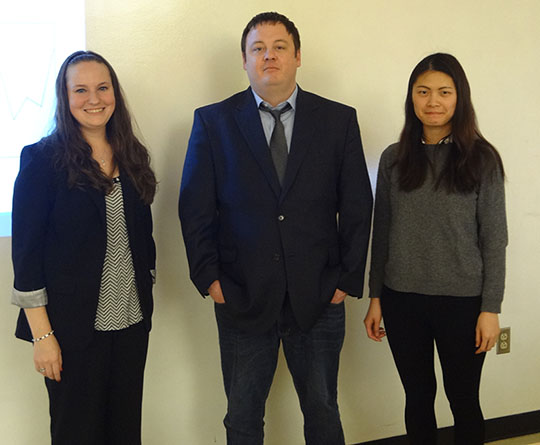
Dr. Michael Crumley (center) served as faculty mentor to Samantha Armstrong (left) and Jingyuan Chen (right).
The Black-Scholes Formula for Option Pricing
We will discuss the Black-Scholes formula, the probabilistic model of stock prices from which it is derived, and some well-studied instances where this formula does not give the actual observed value of real-world option prices. The software, Maple, will be used during the presentation.
Student: Jingyuan Chen
Mentor: Dr. Mike Crumley
Earnings Projections Using Linear Algebra
It is a central problem in all types of business to predict future earnings. Using well-known curve fitting techniques in linear algebra, this problem can be reduced to solving systems of linear equations. We will discuss these techniques and the cautions against putting too much confidence in these projections.
Student: Samantha Armstrong
Mentor: Dr. Mike Crumley
Let Your Computer Do the Shopping: Computer Learning through Bayesian Reasoning
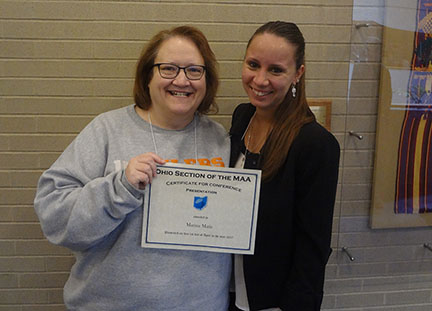
Dr. Pam Warton (left) is the faculty mentor for Matina Matic
Using concepts in machine learning and mathematics, a website was designed to collect data and an algorithm was written to learn user's preferences in regards to fashion.
Student: Matina Matic
Mentor: Dr. Pamela Warton
2015-2016 Findlay Mathematics Research
Optimal Strategies for 4X Games
4X (eXplore, eXpand, eXploit and eXterminate) games have been very popular for decades. In this research, mathematical modeling and simulations were used to determine the optimal strategies for games like Civilization V.
Student: Matt Greer
Mentor: Dr. Pam Warton and Dr. Aaron Blodgett
2014-2015 Findlay Mathematics Research
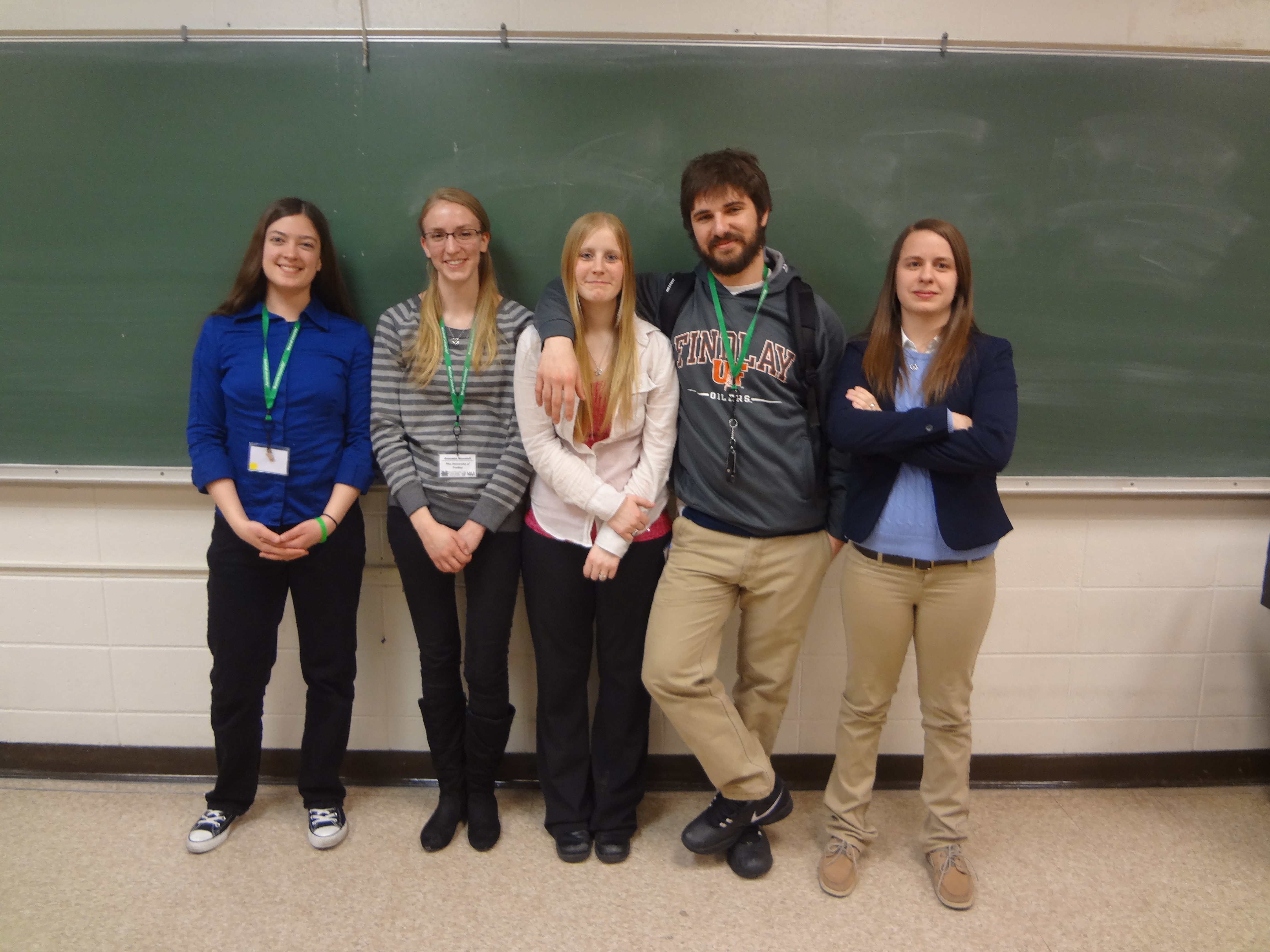
The Elements of Special Relativity
Einstein’s Special Theory of Relativity is founded upon the curious fact that the speed of light as measured by an observer is independent of that observer’s relative motion to the source of the light. Amanda Maxwell discussed some of the surprising and counter-intuitive predictions of this theory, in particular, the prediction that different observers can, and often do, measure different time intervals between the exact same two events.
Student: Amanda Maxwell
Mentor: Dr. Mike Crumley
To Infinity & Beyond: A Study of 3-D Kaleidoscopes
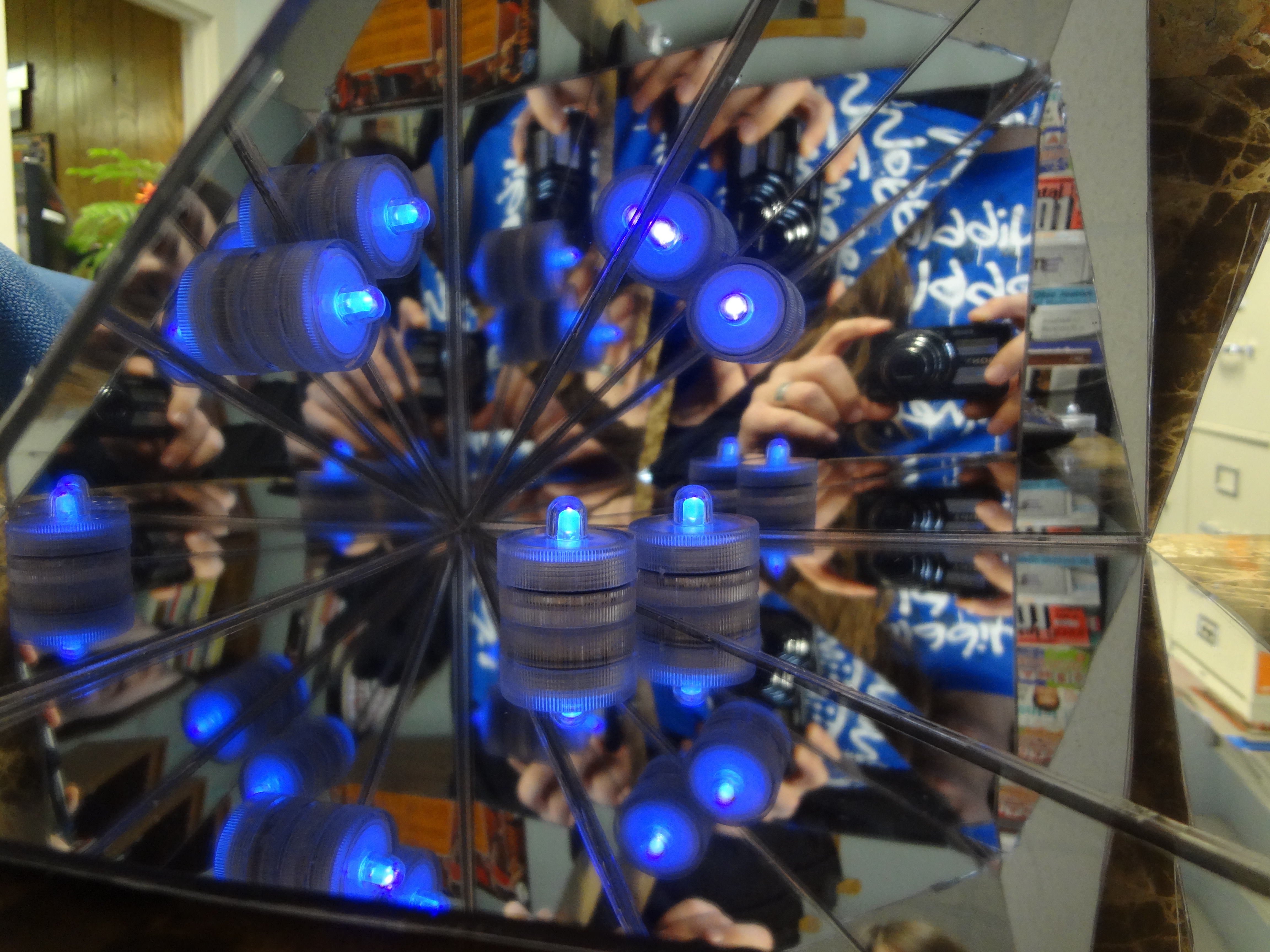
This study examined some of the mathematics behind two-dimensional and three-dimensional kaleidoscopes. Graphics from kaleidoscopes, as well as a model of a three-dimensional kaleidoscope, were presented during the talk.
Student: Bethany Nye
Mentor: Dr. Pam Warton
Predicting the Draft and Career Success of Quarterbacks in the NFL
Each year professional football teams struggle with trying to determine which college athlete will be the most successful in the National Football League. By evaluating pre-selected college statistics of 2015 draft prospects, the success or failure of quarterbacks going into the NFL was predicted. This was completed by examining college and NFL statistics for quarterbacks previously drafted.
Students: Justin Eitner, Kristen Hauser
Mentor: Dr. Pam Warton
Encrypting and Decrypting Text Messages
Inspired by different encryption methods used in the Cryptology Mathematics course, research was planned to decrypt shorthand text message conversations since words would be missing numerous vowels. To explore this idea, standard text messages that included many abbreviated words and phrases were encrypted and then decrypted using the same methods. After deciphering the messages, the object of the research was to figure out how much longer it took to decrypt shorthand text messages compared to normal messages where all of the words were spelled out. Different encryption methods were compared to decide whether certain methods worked better than others with shorthand messages.
Student: Erika Langmeyer
Mentor: Dr. Aaron Blodgett
The Magic of Elusive Triangular Numbers
With collaborators across the country, these researchers showed the existence of an intersection between triangular numbers, Sierpinski numbers, and Riesel numbers. In recent work, the aim is to show that each integer within the representative Sierpinski and Riesel number sequences has at least two distinct prime divisors. A further goal is to prove that infinitely many triangular numbers exist that cannot be written as the sum or difference of two prime powers.
Student: Justin Eitner
Mentor: Dr. Dan Baczkowski
2013-2014 Findlay Mathematics Research
Scrambling Rubik's Cube with Purpose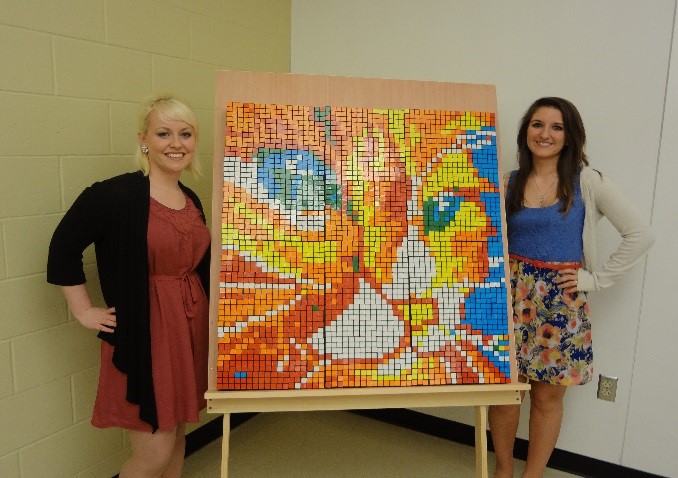
Rubik's cubism has been an art form since the 80's. A digital photograph was pixelated and a mathematical algorithm was written to output the required movements needed to transform a solved Rubik's Cube to match a portion of the pixelated photograph. The pixelated photo was then reproduced with over 150 Rubik's Cubes.
Students: Lacine Myers & Jordan Karg
Mentor: Dr. Pam Warton
Polygonal Numbers, Riesel Numbers, Sierpinski Numbers and More
Polygonal numbers are those that can be expressed geometrically by an arrangement of equally spaced points. Such examples include triangular, pentagonal and hexagonal numbers, which all can be expressed with the corresponding geometric shape. Through the use of coverings, one can find an intersection with these polygonal number sequences and the Riesel numbers or Sierpinski numbers.
Student: Justin Eitner
Mentor: Dr. Dan Baczkowski
2012-2013 Findlay Mathematics Research
Mathematics Madness: Insight on Picking March Madness Brackets
In this presentation, students Alexandria Bishop and Dan Brooks showed the mathematics behind picking the winning teams based on the teams' performance throughout the season. The method is that of paired comparisons and the AHP (Analytical Hierarchy Process) that uses matrices and eigenvectors.
Students: Alexandria Bishop & Dan Brooks
Mentor: Dr. Pam Warton
Avoiding Crime with Mathematics
The use of computers' algorithms has a tight connection with mathematics. This project demonstrates that the statement, through the use of concepts in graph theory, integrates into a Google Maps application. The application aims to construct the safest route from point A to B using local crime statistics. In order to build a path with the least amount of crime, the principles of the shortest path algorithm are implemented except using crime as the driving force. The application incorporates many concepts within computer science as well as mathematics and looks at how the integration of the two can result in new powerful and innovative applications.
Student: Tyler Muryn
Mentor: Dr. Pam Warton
2011-2012 Findlay Mathematics Research
Attack on Lake Erie: Invasion of the Carp?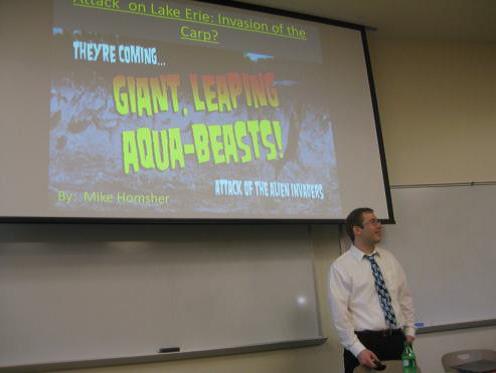
Eugene Braig, IV identified Lake Erie as being the most habitable environment for Asian Carp in the Great Lakes. Given the frequency with which the electric fences near the Chicago seaway goes down, and the ability of the carp to bypass them by jumping, is it probable that two carp could make their way through Lake Michigan, Lake Huron, Lake Erie and then find the Maumee River and, thus, start a colony of reproducing Asian Carp? If so, then we could lend credibility to those who wish to close the seaway and could help provide evidence that could be used to protect the Great Lakes fisheries. Our program attempts to answer the question utilizing random variable generators, combined with their lifespan and swim speed.
Student: Mike Homsher II
Written Work for Online Homework
A qualitative study of student attitudes toward turning in written work for online homework in math was conducted. Students in Math 133, Applied Calculus, Spring 2011, were required to turn in written work for the online homework assigned in the course. At the completion of the course, student participants were asked if they would have kept written work to the degree that they had if it had not been required. Additionally, responses to other questions were collected to judge student study habits. Background on online homework systems, including the pros and cons of online homework in general, and specific attributes of WeBWorK, the system used in the course also will be presented. The researchers concluded that students know what they should do in class to help themselves study, but they do not always do it without some sort of incentive or penalty.
Student: Pam Snowberger
Mentor: Dr. Shelly McGee
The Mathematics of Rating Preferences: A Study of Town Rating Analytics
In the September 2011 edition of Climbing Magazine, a metric that rated towns’ climbability was published. After critiquing the shortcomings of the metric, we propose metrics of our own to rank several variables in American rock climbing towns. Our work relies on creating a norm out of the metric with an origin to measure the distance from the theoretical “worst possible” climbing town.
Student: Alexandria Bishop
Mentor: Dr. Garrett Rea
Typical Student + Fewer Meetings a Week = Less Success? A Statistical Analysis
Data gathered from four semesters of MATH 123: Introduction to Statistics will be analyzed to answer the following questions: Do students who struggle with mathematics tend to sign up for two-day-per-week classes? Do students tend to be more successful when they meet three days each week? How do student success rates compare between two-day-a-week courses, three-day-a-week courses, and online courses?
Student: Logan Opperman
Mentor: Dr. Pamela Warton
Cellular Automaton: Real World Complexity from Simple Origins
This presentation deals with the role of cellular automaton in current research in mathematics, computer science and essential mechanisms of nature. Technology has a complicated structure to accomplish relatively simple tasks. Cellular automaton challenges the status quo that complex systems must have complex origins. We will show that cellular automaton can realize complex behavior from very simple rules.
Student: Ryan Spath
Mentor: Dr. Pamela Warton
2010-2011 Findlay Mathematics Research
Quarantining Worms with a Game of Cops and Robbers
Graph theory plays an important role in information security. Threats are prevalent on networks, and in particular, worms are an example of a malicious mobile code, which can debilitate a network's functionality. By modeling a network with a mathematical graph, playing virtual games of cops and robbers on this graph can provide methods of quarantining the worm in the shortest amount of time.
Student: Mitch Culbert
Mentor: Dr. Pam Warton
When I Was Your Age .....
In the media, it is commonly reported that mathematics students in the U.S. do not compare favorably academically with students from other countries. This situation needs to be addressed; however, to fix the problem, the source needs to be identified. Many argue that the problem is with the educators, the standards or the schools, but the cause has not yet been definitively pinpointed. The presenters will determine if the changes to the textbooks and delivery methods could be a source of the issue. Textbooks in math have changed over the last 50 years in both the content and delivery methods. Could these changes be one of the problems in the education system today?
Students: Tayler Barr, Pam Fink, Megan Limes & Ashton Brown
Mentor: Dr. Pam Warton
2009-2010 Findlay Mathematics Research
The Mathematics of Counter-Terrorism
This project involved using graph theory and discrete mathematics to analyze the terrorist cell network in the United States. The project pinpointed the city that would have the greatest detrimental effect on the national network if the terrorist cells in the city would be shut down. This information would be useful to Homeland Security in order to know which city they should concentrate their resources and focus.
Student: Brittany Fanning
The Chaotic World of Complex Fractals
This project involved investigating the relationship between chaos theory, complexity theory, and the beautiful fractals. Even systems acting chaotically eventually start to form patterns that are actually fractals. This project then focused on understanding the famous Mandelbrot set.
Student: Kora Riding
Mentor: Dr. Pam Warton
2008-2009 Findlay Mathematics Research
Winning Strategies of Monopoly
This project involved setting up a Markov chain to model all of the nuances of the game of Monopoly which resulted in a large matrix. Techniques from linear algebra were then applied to determine which properties would be landed on the most. This project was invited to be written up and submitted for publication to the Pi Mu Epsilon Journal.
Students: Erica Keene and Danielle Rohal
Modeling the Population of the Round Goby in Lake Erie
This project involved gathering data from several state and federal organizations on the invasive species Round Goby in Lake Erie, as well as data on the more desirable species in the lake. Techniques from differential equations were used to develop two different models - one showed that the Round Goby could live in harmony with the other species, and the other showed that the Round Goby would take over the lake habitat and force the desirable fish species out.
Students: Kora Riding and Jeremy Foster
Mentor: Dr. Pam Warton
2007-2008 Findlay Mathematics Research
Bridging the Gap Between Algebra and Abstract Algebra
This project investigates the connection between typical high school algebra and group theory. It takes a historical look at how many topics in group theory were created to determine if a general quantic equation had a general solution.
Students: Ryan McDannell and Erica Keene
Mentor: Dr. Pam Warton
Symmetries of a Cube
After investigating symmetries of many two-dimensional objects, it is natural to explore the group created by the symmetries of a cube. This group along with its cyclic and non-cyclic subgroups are explored, and an isomorphic group is discovered.
Students: Jeraco Speelman and Kendra Bruns